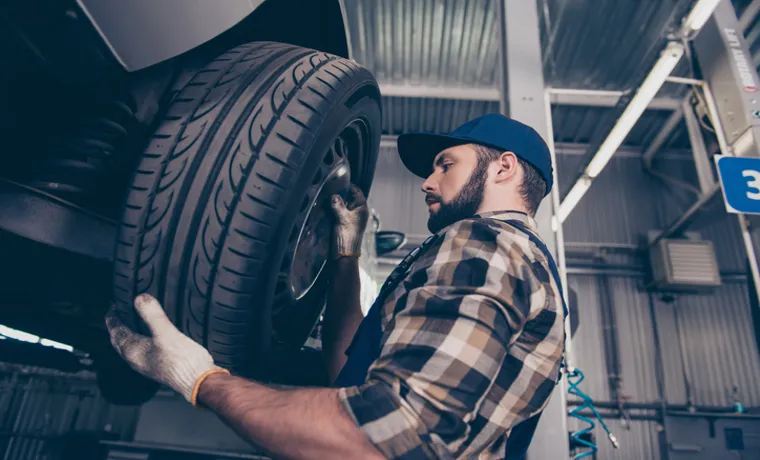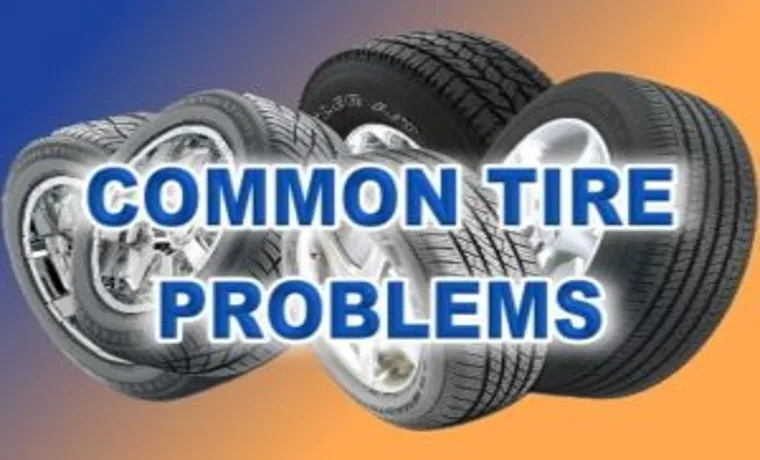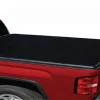Have you ever experienced a flat tire on the road while driving? It’s a frustrating and inconvenient situation that most of us have faced at some point. However, did you know there are other common tire issues that technicians are resolving every day? From worn-out treads to bulges and sidewall damage, there are a handful of tire issues that can put you and your vehicle at risk. In this blog, we’ll take a closer look at the most common tire problems and how technicians are resolving them to keep you safe on the road.
So, let’s dive in!
Table of Contents
Introduction
If you’re wondering what common tire issue technicians are frequently resolving, it’s the problem of tire wear. The tread on your tires naturally wears down over time as you drive, and if left unchecked, this can lead to a whole host of issues. Reduced traction on wet roads, decreased handling, and increased risk of a blowout are just a few examples.
That’s why it’s important to check your tire treads regularly and have them replaced when necessary. A technician can help identify any issues and provide recommendations for repairing or replacing your tires. By staying on top of your tire wear, you’ll not only ensure your own safety but also improve the overall performance of your vehicle.
Explaining the Importance of Regular Tire Maintenance
Regular tire maintenance is an essential component of owning a vehicle as it ensures both safety and cost-effectiveness in the long run. Neglecting maintenance can lead to unsafe and unpredictable driving conditions, as well as costly repairs. It is crucial to check tire pressure regularly, as over-inflated or under-inflated tires can significantly impact handling, fuel efficiency, and overall tire lifespan.
Additionally, inspecting the tread regularly is vital as worn-out tires can lead to decreased traction and increased stopping distance, especially in wet or slippery conditions. Keeping informed about wear and tear on your tires and scheduling routine maintenance can help prolong their lifespan and prevent accidents. As they say, an ounce of prevention is worth a pound of cure.

Common Tire Issues that Technicians Address
As a tire technician, it’s essential to be able to diagnose and resolve common tire issues that vehicle owners experience. One prevalent issue technicians handle is flat tires. If a tire experiences a puncture or punctures, it can lead to air leaking, resulting in a flat tire.
Technicians may either repair the puncture or replace the tire depending on the extent of the damage. Another common issue is tire wear. It’s crucial for technicians to inspect tires for worn-out treads that may impact the vehicle’s performance or cause tire failure.
Additionally, technicians address tire pressure problems, which can lead to reduced fuel efficiency and tire damage. Mechanics ensure that tire pressure is at the proper level and adjust it as necessary. Lastly, misaligned wheels may cause uneven tire wear, decreased stability when driving, and a less comfortable ride for drivers and passengers.
Technicians can identify misaligned wheels and adjust them accordingly to prevent further damage to the tires. Overall, tire technicians are essential for keeping vehicles safe on the road and ensuring that drivers enjoy a comfortable, efficient, and smooth ride.
Flat Tires and Punctures
Flat tires and punctures are some of the most common issues that vehicle technicians frequently face. These issues can arise unexpectedly and if not attended to promptly, can lead to more significant problems. Punctures are created by foreign objects such as nails, screws, or debris on the road that penetrate the tire’s surface, causing a hole and deflating the tire.
A flat tire, on the other hand, is caused by a puncture or a tear in the tire that allows air to escape. Technicians can address these issues by repairing the puncture or replacing the tire. Repairing the puncture involves removing the foreign object and sealing the hole, while replacing the tire involves fitting a new tire onto the vehicle.
Technicians also consider factors such as the size and location of the puncture and the overall condition of the tire before making a repair or replacement.
Balding Tires
One of the most common issues that technicians encounter with tires is balding, or worn out tires. This occurs when the tread on the tire has worn down to the point where it is no longer effective at gripping the road. This is a dangerous situation for drivers as it increases the risk of hydroplaning and decreases overall control of the vehicle.
Technicians address this issue by recommending new tires or potentially performing a tire rotation to even out the wear on the tires. It’s important to regularly check the tread on your tires to ensure they are not balding as this can save you both time and money in the long run. Don’t wait until it’s too late and always prioritize your safety on the road.
Misaligned Tires
When it comes to common tire issues, one that technicians often address is misaligned tires. A misaligned tire can cause a variety of problems, including uneven wear, reduced fuel efficiency, decreased handling and stability, and poor steering response. This can be caused by a variety of factors, such as hitting a pothole or curb, or simply from normal wear and tear over time.
The good news is that this issue can usually be easily fixed by a qualified technician. By aligning the tires and ensuring proper tire pressure, drivers can get back to enjoying a smooth, safe ride. So next time you notice your car pulling to one side or experience any of these other symptoms, be sure to schedule a maintenance appointment with a trustworthy mechanic to get your tires back on track.
Methods Technicians Use to Resolve These Issues
When it comes to tire issues, technicians have a variety of methods to resolve them and ensure your vehicle is safe to drive. One common tire issue that technicians frequently deal with is a flat tire. This can be caused by a puncture from a nail or other sharp object, or simply by wear and tear over time.
Technicians will typically begin by removing the damaged tire from the wheel and inspecting it for any signs of additional damage. They will then determine whether the tire can be repaired or if it needs to be replaced entirely. In the case of a repair, the technician will use special tools to patch the tire from the inside out, sealing the puncture and restoring the tire’s integrity.
If a replacement is necessary, the technician will help you select a new tire that is the correct size for your vehicle and meets your driving needs. They’ll also ensure the new tire is properly aligned and inflated to ensure optimal performance and safety on the road. Regardless of the specific issue, tire technicians have the knowledge and tools to get you back on the road safely and efficiently.
Patching or Replacing Tires
When it comes to tire issues, technicians have two options: patching or replacing them. Patching a tire involves sealing any punctures or leaks, which can often be done in a quick, cost-effective manner. However, if the tire has significant damage or the punctures are not in a repairable area, replacing the tire may be necessary.
Technicians will take into consideration the age of the tire and the depth and location of the damage when determining the best course of action. It’s important to address tire issues promptly to ensure the safety and longevity of your vehicle. So, whether you’re looking to patch or replace your tires, it’s important to trust a knowledgeable and experienced technician to help you make the best decision.
Rotating Tires
Rotating Tires Tire rotation is an important aspect of car maintenance, and technicians use different methods to resolve tire wear and alignment issues. One common method is called the “cross pattern,” where the front left tire and rear right tire are swapped, and the front right tire and rear left tire are swapped. This method ensures that the tires wear evenly and that the car stays balanced.
Another method used by technicians is called “front-to-back,” where the front tires are moved to the back, and the back tires are moved to the front. This method allows for a more even distribution of wear and tear and can improve handling and braking. Technicians also use other methods based on the specific issues that need addressing and the type of vehicle.
For instance, in some cars, tires need to be swapped diagonally because of the way the suspension system is designed. Rotating your tires is essential for maintaining your car’s performance and prolonging the life of your tires. A properly rotated tire can improve your car’s fuel economy, traction, and overall handling.
It’s essential to have your tires inspected by a professional mechanic who can advise you on the best methods and schedules for rotating your tires. By regularly rotating your tires, you can save money in the long run, as you won’t need to replace your tires as often. Plus, you’ll have peace of mind knowing that your car is safe and performing optimally.
So, the next time you’re due for a tire rotation, make sure to consult with your mechanic and employ the best method suited for your car.
Wheel Alignment
Wheel alignment issues can arise from a variety of factors such as hitting a pothole or curb, worn out suspension parts, or even just regular wear and tear on your vehicle. Luckily, there are several effective methods technicians use to resolve these issues. The first step is to assess the extent of the misalignment using specialized tools and equipment.
Next, they will adjust the camber, toe, and caster angles accordingly to get your wheels back into proper alignment. In some cases, they may also need to replace any damaged or worn out suspension components to fully correct the issue. It’s important to address wheel alignment issues as soon as possible to prevent uneven tire wear and potential safety hazards on the road.
So, if you notice any signs of misalignment such as your vehicle pulling to one side or experiencing shaky or loose steering, be sure to bring it in for a professional assessment and repair.
Conclusion
In conclusion, the technician is resolving the common tire issue of misalignment. It’s not just enough to have top-of-the-line tires, you also need to make sure they are aligned properly. Otherwise, you’ll be driving around in circles (quite literally!) and wearing your tires out unevenly.
So, remember to give your tires some love and alignment, and they’ll take care of you in return!”
Emphasizing the Importance of Consulting with Technicians
When it comes to resolving technical issues, consulting with technicians is an important step to take. Technicians have a wealth of knowledge and experience in dealing with a variety of problems that may arise. They use a range of methods to diagnose and resolve issues, such as running diagnostic tests, checking hardware and software settings, and consulting with other experts in the field.
One of the key advantages of consulting with technicians is their ability to troubleshoot problems in a systematic way, honed over years of experience. They use their expertise to identify the root cause of the issue, rather than simply addressing the symptoms. This means that issues are resolved more efficiently, saving you time and money in the long run.
Additionally, technicians can provide valuable advice on how to prevent similar issues from occurring in the future. Therefore, it is always wise to enlist the help of a technician when technical issues arise.
FAQs
What is the most common tire issue that technicians encounter?
The most common tire issue that technicians resolve is a punctured or flat tire.
What are the signs of worn out tires?
Signs of worn out tires include low tread depth, uneven wear, visible cracks or bulges on the tire sidewall, and frequent loss of tire pressure.
Can a punctured tire be repaired?
Yes, a punctured tire can be repaired if the puncture is not too big and is located on the tread area of the tire. However, if the puncture is on the sidewall or the tire has sustained too much damage, it may need to be replaced.
How often should I check my tire pressure?
It is recommended to check your tire pressure at least once a month and before long trips.
Can I use different tire brands or sizes on my vehicle?
It is recommended to use the tire brand and size recommended by the vehicle manufacturer to ensure proper handling and performance. However, in some cases, certain tire brands or sizes may be compatible.
What is the recommended lifespan of a tire?
The recommended lifespan of a tire is around 6 years, regardless of the tread depth. After 6 years, the tire should be replaced even if it appears to be in good condition.
How can I extend the lifespan of my tires?
To extend the lifespan of your tires, you should maintain proper tire pressure, avoid overloading your vehicle, rotate your tires regularly, and avoid harsh driving habits such as sudden stops and starts.



